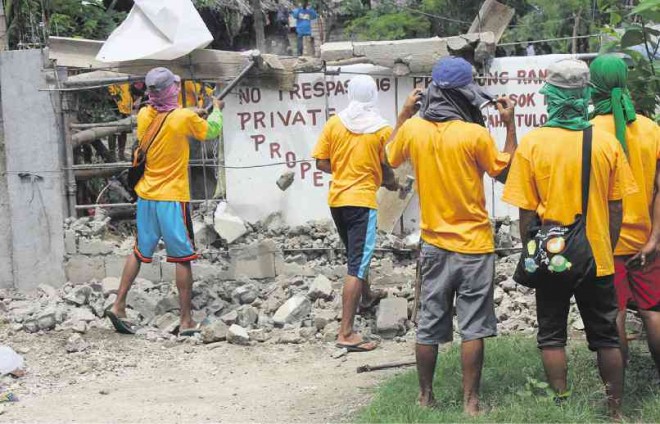CARP finally wins in Quezon estate

GOVERNMENT workers demolish a wall of Hacienda Matias in San Francisco, Quezon province. FOOD FIRST INFORMATION AND ACTION NETWORK/CONTRIBUTOR
LUCENA CITY—A steel gate of the controversial Hacienda Matias in San Francisco, Quezon province, which had long been the symbol of resistance of rich landowners against the government’s agrarian reform program, finally went down last week.
The demolition of the lone gateway to the 1,715-hectare coconut estate was similar to the destruction of the infamous Berlin Wall in Germany, according to Jansept Geronimo, spokesperson for Kilusan para sa Tunay na Repormang Agraryo at Katarungang Panlipunan (Katarungan).
“The land reform beneficiaries were all ecstatic. The removal of the gate had long been their fervent wish,” Geronimo said in a phone interview.
Hacienda Matias straddles the villages of Barangay Butanglad and Don Juan Vercelos, 15 kilometers from the town center of San Francisco at the tip of the Bondoc Peninsula. The place had long been a hotbed of agrarian unrest.
Before daybreak on July 2, Undersecretary for Legal Affairs Luis Meinrado Pangulayan and other officials of the Department of Agrarian Reform (DAR) arrived with more than 200 policemen and Army soldiers in Hacienda Matias to resume the formal installation of 283 beneficiaries of the Comprehensive Agrarian Reform Program (CARP).
Article continues after this advertisementRepresentatives from other government agencies, like the Department of Justice, Department of the Interior and Local Government, Department of Social Welfare and Development, Commission on Human Rights, municipal agrarian reform officials and court sheriff also joined Pangulayan.
Article continues after this advertisement“All illegal structures primarily consisting of concrete and steel barriers set up by the former landowners to obstruct the reinstallation of the ARBs (agrarian reform beneficiaries) were also demolished,” Director Erlynda Manluctao, head of the Department of Agrarian Reform (DAR) public assistance and media relation office, said in a statement on Friday.
They had tried to install the farmers on May 23, but they were forced to back off when hacienda workers barricaded the gate with drums and a herd of cattle.
Originally made of bamboo, the gate was put up in 2004 after the DAR sent a “notice of (CARP) coverage” to the land owners. It was later changed to a swinging steel gate and manned by workers hired in the hacienda.
Using an acetylene torch, court-deputized workers demolished the gate and the concrete walls along the front perimeter of the estate. The land owners hurriedly put up the walls after authorities destroyed the barbed-wire fire in their first installation attempt, Geronimo said.
He said not a single hacienda worker showed up and protested. “Some of them were spotted just taking photos from their mobile phones from the distance,” he added.
“Most of us shed tears of joy. We’re all happy,” Maribel Luzara, president of the Kilusang Magbubukid ng Bondoc Peninsula (KMBP) and a beneficiary, said over the phone.
She had been attending to the needs of close to 100 beneficiaries who had just returned home from a monthlong camp-out in front of the DAR headquarters in Quezon City to protest problems in their installation when the government officials arrived at the hacienda for the second time.
Luzara described the removal of the gate as the “symbol of victory to our long years of struggle.”
Triumphant CARP beneficiaries carrying farm implements were the first to cross the fallen gate, according to her. They went straight to their farms and started harvesting coconuts.
Guillermo Catandihan, the hacienda overseer and workers’ leader, said they had decided not to resist to avoid bloodshed. “We could not do anything against the massive forces of government. We avoid violence that could only hurt people,” he said when reached on his mobile phone.
On Thursday, police arrested Catandihan, his brother Aladin Sr. and his son Aladin Jr. for obstruction of CARP implementation. They were arrested by virtue of a warrant issued by a court in Lucena City on May 21.
The legal counsel of the Matias family, Victor Gimenez, had yet to reply to calls made by the Inquirer by cellphone to seek reaction to the DAR operation. In a previous interview, Gimenez maintained that the decision of the DAR to distribute the land was not final, citing his client’s right to bring the case to the Court of Appeals.
Senior Supt. Ronaldo Genaro Ylagan, provincial police chief, said more than 150 policemen with truncheons and batons, accompanied the DAR delegation to the hacienda. They were ready to stay there for 15 days to help maintain peace and order during the installation process, he said.
The process involves the formal assignment of lots to the beneficiaries, all of whom have received their certificates of land ownership award (Cloas) last year, and their orientation to the lot boundaries. The farmers were awarded about half of the estate covering three of the seven titles.
The other lots covered by other titles are now in the name of the government and waiting to be distributed to qualified beneficiaries.
Despite their Cloas, the farmers were unable to occupy the land, claiming they were harassed by armed men working for the hacienda owners and that their coconut produce were forcibly taken from them.